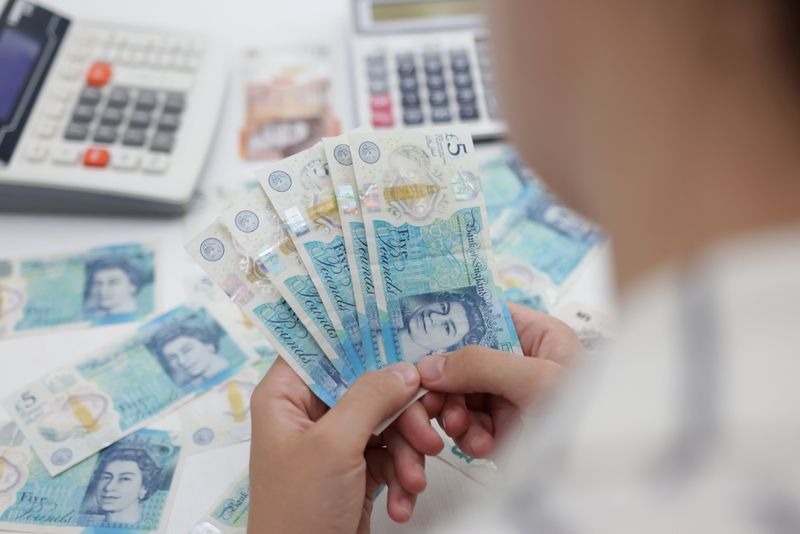LONDON (Reuters) -Tight monetary policy coupled with a penny-pinching fiscal agenda usually results in currency appreciation, and sterling is surging on the prospect. But it’s far from clear why the UK government or the Bank of England want a rising pound right now.
This week’s BoE decision to hold off on its second interest rate cut of the year was billed by many central bank watchers as an expected “non-event”.
But the freeze is more meaningful – and even a little head-scratching – given what the BoE’s G7 peers are doing – not least the Federal Reserve’s outsize half point rate cut the previous day and the European Central Bank’s second rate cut of 2024 last week.
Keeping the UK policy rate at 5% may simply be a matter of messaging, as the BoE seemed to suggest.
It could be a signal to wage bargainers that they need to curtail their expectations and a call for service sector firms to tamp down on still-high price rises. Or it may just be reasonable hesitation, as the BoE is waiting for the concrete data it’ll get in the new Labour government’s first budget, set to be released next month.
But with the BoE’s repeated stress on stamping out inflation “persistence”, it took a distinctly more hawkish tone than other big central banks have recently – so much so that markets now think the chance of a BoE cut in November is below 70%, compared to a sure thing before the meeting.
And where markets see the UK’s easing cycle ending up is just as harsh.
The implied “terminal rate” is currently around 3.4%, which the central bank is expected to reach by the end of next year. That is almost 50 basis points higher than the Fed’s equivalent rate, 150 bps above the ECB’s and Bank of Canada’s and 300 bps over the Bank of Japan’s.
These policy rate premiums are all higher than they were in the decade before 2022’s worldwide scramble to tighten.
It’s not entirely clear what justifies this. Are today’s underlying UK inflation pressures really that much worse that those in other major economies? Has the UK’s historical vulnerability to inflation resurfaced? Or has Brexit thrown a spanner in the works in the interim?
The market’s longer-term rate horizon also seem puzzling when considering other details of the central bank’s outlook.
In its meeting statement, the BoE downgraded its GDP growth forecasts for the current quarter, said services inflation would ease further by year-end, and noted that surveys show public inflation expectations are falling back to pre-pandemic levels as headline inflation skirts its target 2%.
The economic drag should be bigger if the upcoming government budget is true to early indications and tightens fiscal policy with a mix of tax rises and spending cuts needed to fill a much-touted 20 billion pound ($26.55 billion) hole in public finances.
STERLING STARRING
Sterling seems to love it. The promise of relatively tight monetary and fiscal policy has pushed the pound to its highest level against the dollar in more than two years. And it’s a whisker from its two-year highs against the euro.
Sterling’s trade-weighted index is up more than 3% this year alone, and is a stone’s throw from its highest point since the Brexit referendum in 2016.
Given that trade-related Brexit problems are at least part of the UK’s growth problem, a surging pound can hardly be all that helpful right now.
Even if a strong pound puts downward pressure on imported energy or commodity inflation, that hardly helps the BoE. Its stated concern is domestic services and wages, which are largely unrelated to the exchange rate.
The BoE did note that the pound’s effective exchange rate had appreciated more than 1% since its previous meeting, though it blamed the U.S. rate shifts and related dollar move for most of that.
‘IDIOSYNCRATIC’
If it’s all simply a question of timing, then the BoE will have to accelerate its easing eventually and some economists think it will.
“If the government is more stringent on fiscal policy, we think the Bank will be forced to increase the pace of the cutting cycle to offset the hit on both households’ and businesses’ finances,” said AXA Investment Managers economist Gabriella Dickens, adding there was an outside chance of two cuts by year-end.
And the central bank may find itself with some considerable catching up to do.
Jefferies economist Modupe Adegbembo said while there may be “idiosyncratic” reasons for UK inflation persistence, pressure on the BoE to deliver two more cuts this year will rise meaningfully if the Fed were to ease by yet another 50 bps at its next meeting.
So the pound may have good reason to be where it is right now – but this strength could evaporate quickly if it’s relying solely on such a high BoE landing zone.

The opinions expressed here are those of the author, a columnist for Reuters
($1 = 0.7534 pounds)
(By Mike Dolan; Editing by Jamie Freed)
To read the full article, Click Here

